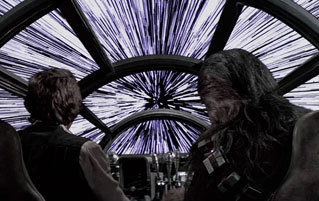5 Things Movies Always Get Wrong About Space

Chances are none of us will live long enough to see mankind achieve the awesome space-faring dreams that science fiction has instilled in us. We will not personally explore that final frontier; we will not settle the stars; we will not meet interesting new civilizations and bang them. The thought alone is enough to drop-kick your soul into a thermal exhaust port. But thanks to Hollywood magic, we've at least got a pretty good idea of what it's like out there. Right?
Not so much. Movies are all about showing you awesome stuff first and factual accuracy second, or third, or maybe 10th, depending on how much cleavage or Tom Cruise running the director wants to slip in there. Of course, we wouldn't have it any other way; just keep in mind that ...
Space Explosions Don't Look That Impressive (Although They're Even More Dangerous)

Whether it's Death Stars going off like moon-size cherry bombs or Captain Picard solving the ever-loving shit out of a galactic Rubik's Cube ...
... we've got a crystal clear picture of what it's like to explode something in space. And that picture is awesome.
The Reality:
Without atmosphere (and oxygen to burn), where the hell are those giant fireballs coming from? In reality, a space explosion looks less like apocalyptic blasts and more like an object that got up one morning and said, "To hell with it. I'm calling in sick to existence." And you know what else requires air in order to register? Sound. That's right: In addition to lacking all those sexy pyrotechnics, a space explosion would also be more or less silent.
Here's a side-by-side comparison with one explosion taking place in an Earth-like atmosphere and another in a space-like vacuum:

Assuming that space explosions don't use magic fireballs.
Explosion on the left: a Michael Bay orgasm. Fire. Sound. Fury. That's the Earth-bound one, obviously. Explosion on the right: disappointingly subdued. A gentleman's explosion. That's how it would really play out in space.
Now, none of this is to say that space explosions aren't completely and totally terrifying. It's just the visual element that's lacking. The same lack of atmosphere that prevents fireballs and sound from wreaking 360 degrees of awesomeness also allows for a lot more destruction. Unlike an Earth-bound explosion, you can't nonchalantly walk away from a cosmic car bomb while donning your sunglasses. Just like an atmosphere-restrained explosion, you've got tons of shrapnel to deal with. But unlike terrestrial explosions, space shrapnel hurtles out in every direction, and it does not slow down or stop until it encounters something. That X-Wing zooming away from the exploding Death Star? Hope it's got a lot of fuel; as soon as it stops, it's getting shredded like cheese. Well, we suppose it could just, like, turn off to the side and dodge the shrapnel or something, but Prometheus has told us that sort of thing is impossible everywhere but Earth.
Dogfights in Space Wouldn't Look Like That

If you're anything like us (i.e., you spent a decent chunk of your childhood running around the house with a plastic X-Wing, firing marbles at the Death Star that is your little brother's head), you have a pretty good idea of how dogfighting works in space. Just like it works down here, only six times as awesome, because it's friggin' space!

Men will sit in the cockpits, because how else could we ever pilot aircraft?
The Reality:
Unlike an airplane on Earth, which has to keep constant thrust just to maintain flight, if an X-Wing zoomed around with its engines constantly roaring the way they're depicted in the movies, those dogfights wouldn't range across the whole Death Star -- they'd range across the whole damn solar system.
Turning in space is an entirely different ballgame as well. If you're flying an F-22 on Earth and need to change directions, you do what's called a banking turn, which looks something like this:

Mmmm, check out those curves.
The jet tilts, its wings redirect the air around it while a cushion of air builds up in front of it, and all those forces plus its momentum make it go in the new direction. Take away the air, though, and there's no longer any such thing as a banking turn. All that sweeping and swooshing and banking that happens in the sci-fi films would realistically look more like this:

Less Star Wars, more Space Invaders.
It may not look like Top Gun (and in our book everything gets -10 points for not looking like Top Gun), but there's one other factor to consider: No air and no resistance also means that turning at top speed doesn't damage your craft, slow you down, or even significantly change your direction of travel. You might remember one of the most famous photos ever taken of Earth from space, the Pale Blue Dot:

"#NoMakeup. #NoPhotoshop."
On its way out of our solar system, NASA had Voyager 1 spin right around and snap that photo -- all while traveling at over 35,000 miles per hour. It didn't veer off course to do it, either. In space, a quick 180 just ain't no thing. Which means that there was no reason Luke couldn't have spun right about and blasted the TIE fighter off of his own ass without so much as tapping the brakes, thereby rendering Han Solo's last-minute save completely superfluous.
Stars Don't Streak by You (No Matter How Fast You're Going)

It's one of the most iconic scenes in science fiction: Chewbacca does the interstellar equivalent of punching it, and the stars streak right past the Millennium Falcon. Picard says "Engage," and two things happen: One, you fall a little bit more in love with him, and two, the stars turn into a tunnel of light. Goddamn, that man is magical.

"This sight is the main reason we travel at night."
Makes sense, right? Things whiz past you and blur together when you go fast. Stars are things. Whiz past 'em super fast in space, and they'd get all blurry. Physics ain't complicated, folks.
The Reality:
Oh wait, physics is actually really goddamn complicated.
It turns out that as you approach lightspeed, physics gets sort of wonky. NASA put together a demonstration of what it would look like to travel down the universe's longest street while approaching at lightspeed, and what basically happens is that all the light washes out of your surroundings and converges in front of you until it looks like you're trekking toward a bright dot on the horizon. So, in actuality, traveling in hyperspace would look less like streaking stars and more like how your great-aunt describes her near-death experience.

"Don't laugh. Quantum physics killed your Uncle Paul on your grandmother's side, too."
But that wouldn't be nearly as nifty to watch. If our favorite bald Adonis said "Engage," and the screen suddenly went black save for a lone blurry little pinpoint of light, you wouldn't assume that meant they were going super-fast; you'd probably just assume Patrick Stewart has the psychic ability to break your TV.
Gravity Won't Yank You Out of Orbit Like a Magnet

Pop quiz: What happens when a spaceship in high orbit loses its thrust? According to sci-fi logic, the ship will immediately drop like a rock toward the surface of whatever it's orbiting, just like General Grievous' ship in Revenge of the Sith or the Enterprise in Star Trek into Darkness. (If it seems like we're picking on Star Trek and Star Wars too much, it is only because we love them. This is the nerd version of pulling pigtails on the playground.)

"Good luck trying, assholes. Why do you think I wear my hair like this?"
The Reality:
Someone way smarter than us already did the math on that Star Trek scene we mentioned above, and it turns out that the dead-in-the-water Enterprise would actually have taken about 80 hours to fall into Earth's atmosphere from that height. It's understandable why that didn't make the movie: Two solid work weeks of watching Sulu polish his sword before crashing into the planet might derail the pacing a bit.
Much to the dismay of your average sci-fi space battle scene, gravity isn't a giant invisible rubber band that snaps you to the planet's surface like a paddle ball as soon as you stop resisting it. And not only would the Enterprise's plummet have been more of a leisurely descent for much of the way, but if the crew had actually managed to achieve orbit before losing power, the ship wouldn't have fallen at all. Not one bit of thrust is required to remain in a stable orbit once you're there -- just ask Vanguard 1. One of the first artificial satellites ever launched, it's still happily floating more than half a century later.

"Log 12837: little lonely, but otherwise happy."
Well, OK, maybe we're embellishing a bit. Orbits do eventually decay. Vanguard 1 was originally expected to orbit for 2,000 years, but thanks to greater-than-expected effects of atmospheric drag, that estimate got knocked down to a mere 240. So the next time you're watching a thrilling space saga and the brave Captain Beef Thickpack says, "Without our engines, our orbit will decay, crashing us into the planet below!" just mentally append "in about 10 generations."
Zero Gravity Does Not Equal Slow Motion

If 2001: A Space Odyssey taught us anything, it's that Siri will one day murder us all. Oh, and also that moving around in space is like swimming through an infinite vat of invisible pea soup. Everything from space walks to cinematic spaceship flybys to Borg death-stomps will happen in the slowest of sloooow mooootions.

We'll even jog slowly, whatever that means.
The Reality:
Why would things move slower in space, unfettered by the fascist repression of atmosphere and gravity? In fact, they actually tend to go faster. Since there's a near complete lack of external forces, as long as a spacecraft is firing its thrusters, it's accelerating (up to a certain extent, of course). That's why rocket scientists use the concept of delta-v -- basically saying, "How much fuel are we going to have to burn to pull that shit off?" Spacecraft are limited not by surrounding forces, but by how much fuel they have left and how tired someone at mission control is of holding down the GO! button.
So why do actual astronauts look like they're constantly pantomiming through peanut butter? It is solely the fault of the astronomical assload of gear they have to wear. You go suit up in an incredibly bulky, insanely expensive spacesuit (you break it, you buy it ... and, uh, you also die), and then see how sprightly you are.

That thing weighs a ton. Well, it weighs nothing, but you know what we mean.
And if you've ever seen video from inside the space station and wondered why everybody looks like they're running in a dream, that's not because quick movements are impossible. They're just not advisable. Jump-kicking across the length of the ISS might sound awesome, but the only thing absorbing all that force when you reach the other side is your own squish-filled meatsack. Even if you survive unscathed, all of that seriously expensive and utterly vital equipment is now smashed to bits.
The slow movements you see in real space footage aren't the astronauts wading through some weird, invisible space jam; it's simply them being very, very careful. But we're pretty sure every astronaut has jump-kicked across the ISS at least once, just to get it out of their system.
Related Reading: Did you know space holds a gigantic liquor cabinet big enough for God? And were you aware that Zambia had a space agency? The story is more ridiculous than you can imagine. We've got crazier stories than that, though -- check out the most badass things ever done in space.
